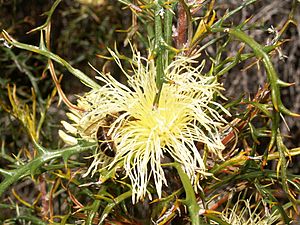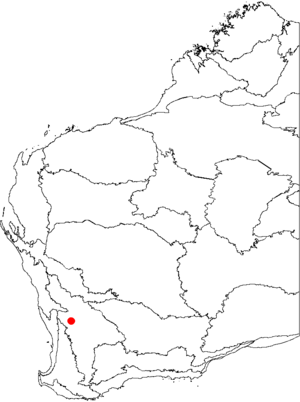Banksia wonganensis facts for kids
Quick facts for kids Banksia wonganensis |
|
|---|---|
 |
|
| Scientific classification | |
| Genus: |
Banksia
|
| Species: |
wonganensis
|
| Synonyms | |
|
Dryandra wonganensis A.S.George |
|
Banksia wonganensis is a large shrub that grows only in Western Australia. Before 2007, it was called Dryandra wonganensis. This plant is found in a small area around the Wongan Hills. It likes to grow in red, rocky soils in open forests or thick bushes. It is a rare plant, but it is not currently in danger of disappearing.
Contents
What Does Banksia wonganensis Look Like?
This plant is a shrub that can grow up to 3 meters (about 10 feet) tall. It can spread out or grow straight up. Unlike some plants, it does not have a special woody lump called a lignotuber at its base.
Its leaves are long and thin, about 4 to 16 centimeters (1.5 to 6 inches) in length. They are also about 9 to 18 millimeters wide. The leaves have four to nine triangle-shaped parts on each side. They often curve a lot and end in a sharp point.
The flowers are bright yellow. They grow in round clusters, with about 45 to 50 flowers in each cluster. These flower heads can be up to 3.5 centimeters (about 1.4 inches) across. Each flower has a tube-like outer part called a perianth. This perianth is made of four fused parts. There is also a long, thin part called a style. The tip of the style is first held inside the flower. But it breaks free when the flower opens fully.
After the flowers bloom, small woody pods called follicles grow at the base of the flower head. Each pod usually holds one or two seeds.
How Did Banksia wonganensis Get Its Name?
Scientists have been collecting Banksia wonganensis for a long time. For example, Alexander Morrison collected some in 1903. Later, in 1985, a scientist named Robert Malcolm Sainsbury mistakenly thought these plants were a different species.
However, it was later realized that this was a new species. In 1996, Alex George, a botanist, officially described the plant. He named it Dryandra wonganensis. The name "wonganensis" comes from the Wongan Hills where it is found. The Latin word "ensis" means "origin" or "place."
In 2007, two scientists, Austin Mast and Kevin Thiele, made a big change. They decided that all plants in the Dryandra group should actually be part of the Banksia group. So, the plant's name changed to Banksia wonganensis to reflect this.
Where Does Banksia wonganensis Live?
Banksia wonganensis grows only in the Wongan Hills area of Western Australia. This area is part of the Avon Wheatbelt biogeographic region. A biogeographic region is an area with similar plants, animals, and climate.
The plant prefers red, rocky soils. It grows in open forests or thick bushes. The area usually gets about 350 to 400 millimeters (14 to 16 inches) of rain each year. The temperature usually ranges from 11.1 to 24.3 degrees Celsius (52 to 76 degrees Fahrenheit). It can also have up to 80 days a year where the temperature is above 30 degrees Celsius (86 degrees Fahrenheit).
How Does Banksia wonganensis Survive?
Like many other plants in the Proteaceae family, Banksia wonganensis has special roots. These are called proteoid roots. They are dense clusters of short roots that form a mat just under the leaf litter. These roots help the plant take in nutrients from poor soils. This is important because Australian soils often lack nutrients like phosphorus.
This plant does not have a lignotuber. This means it dies if there is a bushfire. However, it is adapted to release its seeds after a fire. This helps new plants grow quickly and replace the ones that burned.
The government of Western Australia has listed Banksia wonganensis as "Priority Four - Poorly Known Taxa." This means that scientists have studied it enough to know it is rare. But it does not seem to be in danger of disappearing.
Growing Banksia wonganensis
Not many people grow Banksia wonganensis in their gardens. However, some experts say its leaves are pretty and its flowers are showy. They believe it is as attractive as many other large shrubs in its group.
This plant likes heavy soils that drain water well. It can grow in full sun or light shade. It is also good at handling both dry weather and frost. If you try to grow it from seed, only about half of the seeds usually sprout. But when they do, they grow quickly, often in less than four weeks.


